Tomatoes are a fantastic, versatile fruit. The many tomato varieties, ranging from huge beefsteak tomatoes to bite-size cherry tomatoes, make it the perfect ingredient for everything from Caprese to fried green tomatoes, ketchup to salsa, and more. Even better, tomatoes thrive in a surprising range of conditions. Tomatoes are a popular choice for hydroponics systems for this reason. Growing tomatoes hydroponically offers growers various options for a bountiful harvest.
Despite the resilient nature of most tomato varieties, they require specific nutrients and conditions to thrive. Today, we’ll journey through a complete guide for success with your hydroponic tomatoes and why they’re an excellent choice for gardeners.
First, Why Hydroponics?
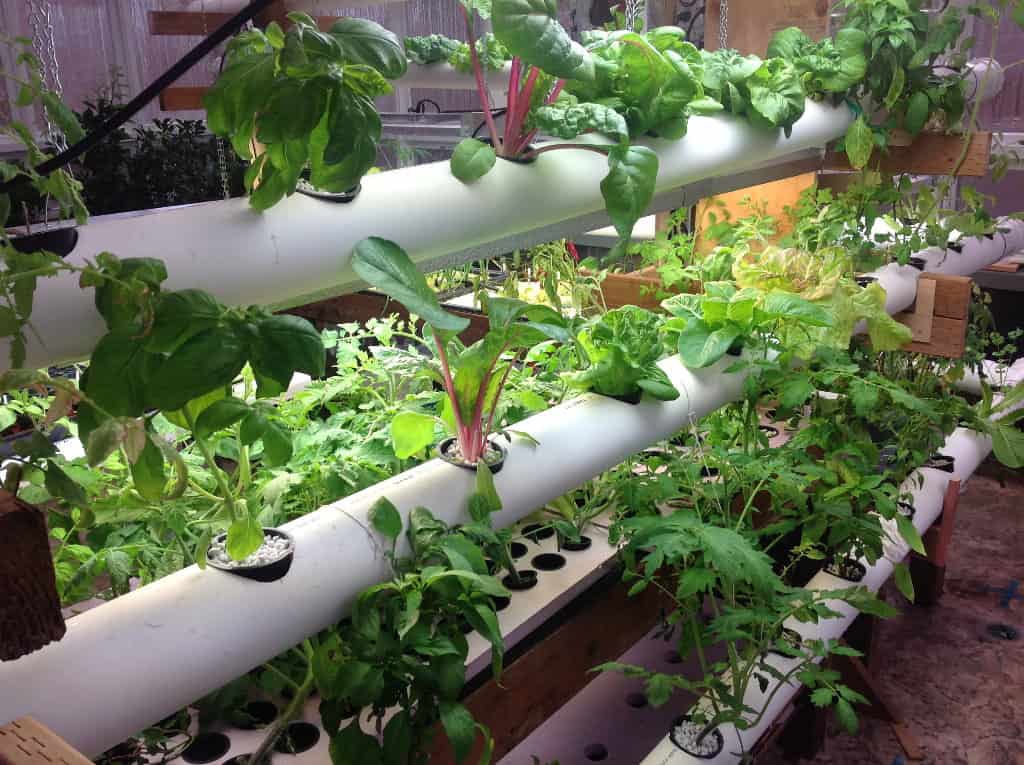
A mixture of hydroponics systems shows the versatility and variety of plants that can be grown hydroponically.
©Oregon State University / CC BY-SA 2.0 – Original / License
There are multiple benefits to growing hydroponic tomatoes. Some include the advantages of hydroponics, like a cleaner growing space without soil, while some relate to the tomatoes themselves. Let’s take a look:
- Year-round growth — no need to wait for the proper season
- No soil means less mess and no soil-related diseases or pests
- More control over nutrient applications
- Increased water efficiency
- Better nutrient absorption by the tomatoes, resulting in better quality fruits
- More efficient growth cycles mean faster and more substantial harvests
The primary benefit of growing tomatoes with hydroponics is being as hands-on as you’d like. You don’t need to worry about uncontrollable forces like the weather. In addition, tomatoes specifically benefit from this level of attention, and you will see a significant reward for your efforts
The Best System for Tomatoes
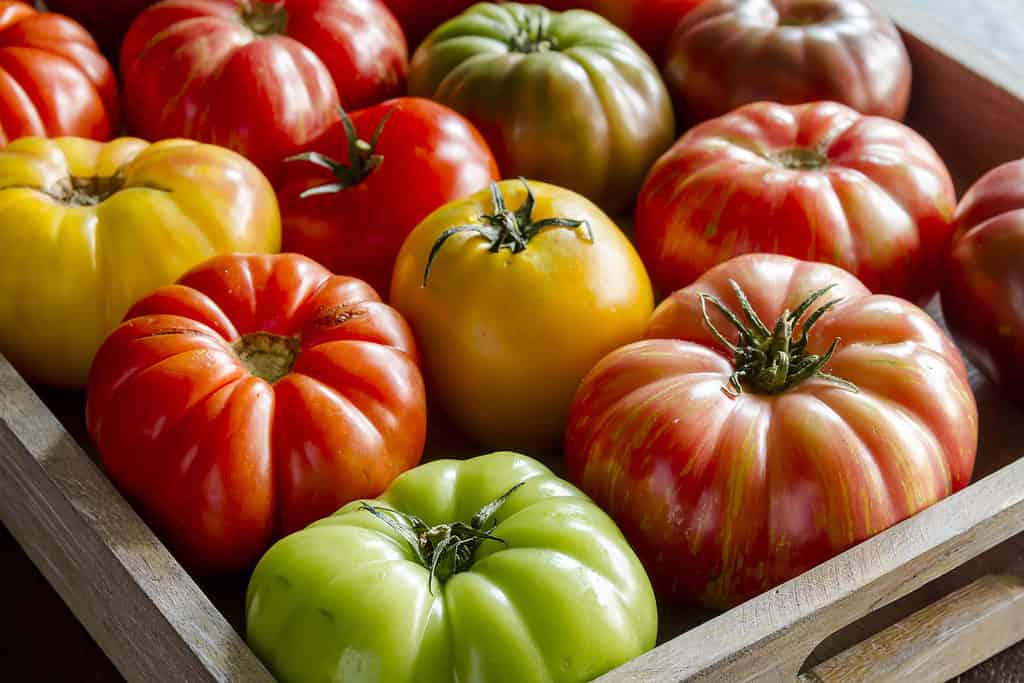
Tomatoes make great candidates for hydroponics due to their high water content and particular nutrient needs.
©Teri Virbickis/Shutterstock.com
Several types of hydroponics setups exist, each with benefits and considerations. Feel free to skip this section if you already have a setup that works for you. For those new to hydroponics, keep reading.
Most hydroponics systems consist of similar components: water reservoirs, liquid nutrients, plants in growth medium, and a way for the water to reach your plants. The watering process is automatic in most systems, but you still need to monitor other components. Different types of systems exist on every level, ranging from branded all-in-one systems that are more expensive to smaller, homemade systems that you can assemble yourself.
Hydroponics growers have success with tomatoes in various systems, including deep water culture (DWC), ebb and flow, drip, nutrient film technique (NFT), and more. The best depends on your garden expectations, including the space you dedicate to your tomatoes and the system’s complexity. Most sources agree that DWC, ebb and flow, and drip are some of the best systems for tomatoes.
Deep Water Culture

Deep water culture systems are easy to set up and maintain with plant roots suspended in a water and nutrient mixture.
DWC can seem to be the most similar to traditional soil planting of all the hydroponic systems. However, instead of soil, your plants continually sit in water. DWC can be one of the most consistent systems to set up and use, though some water values can fluctuate significantly in smaller setups.
One of the critical points of DWC is aeration. Your plants will drown without a way to get air to the roots. Most DWC systems use an air stone or other bubbler to oxygenate the water. That, alongside your liquid nutrients, will ensure your plants are well-fed and happy.
DWC systems require minimal setup and maintenance beyond monthly reservoir flushes and bubbler cleaning. However, one of the main risks of this type of hydroponics is the water. Your plants’ roots are permanently submerged, meaning that changes in nutrients, water temperature, and pH balances will quickly affect your plants.
Ebb and Flow
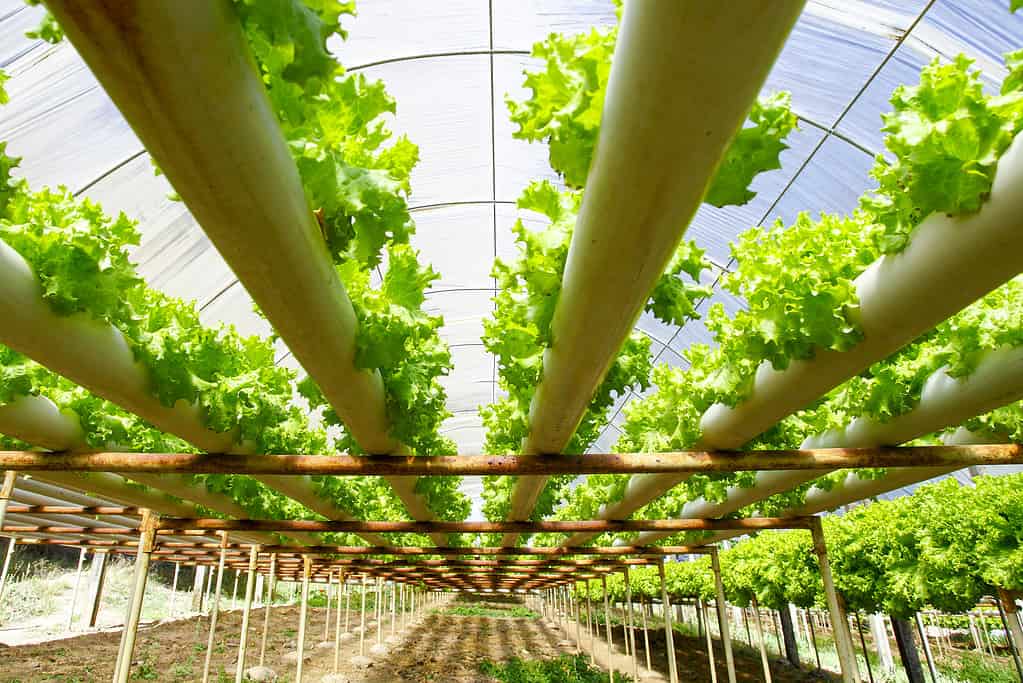
Hydroponics, such as the ebb and flow system, are frequent in commercial agriculture.
©ribeirorocha/iStock via Getty Images
Unlike DWC, ebb and flow systems periodically flood your plant’s roots with high-nutrient water and then drain back the water to let the roots breathe. Fittingly, these systems are also called “flood and drain” systems. Timers control these cycles for maximum nutrient storage and growth.
Ebb and flow hydroponics systems require more equipment than others, namely the tubing and pumps required to move the water. However, most systems use gravity to drain the food tray into the reservoir, so that’s one less layer of complexity.
Though they require slightly more setup, ebb and flow systems are a great example of self-sustaining processes. With the timers to control the pumps, there’s very little oversight required. Plus, compared to DWC systems, water changes aren’t as drastic or precise. However, Ebb and flow systems require more frequent cleaning and maintenance and run the risk of roots becoming too dry in between floodings.
Drip
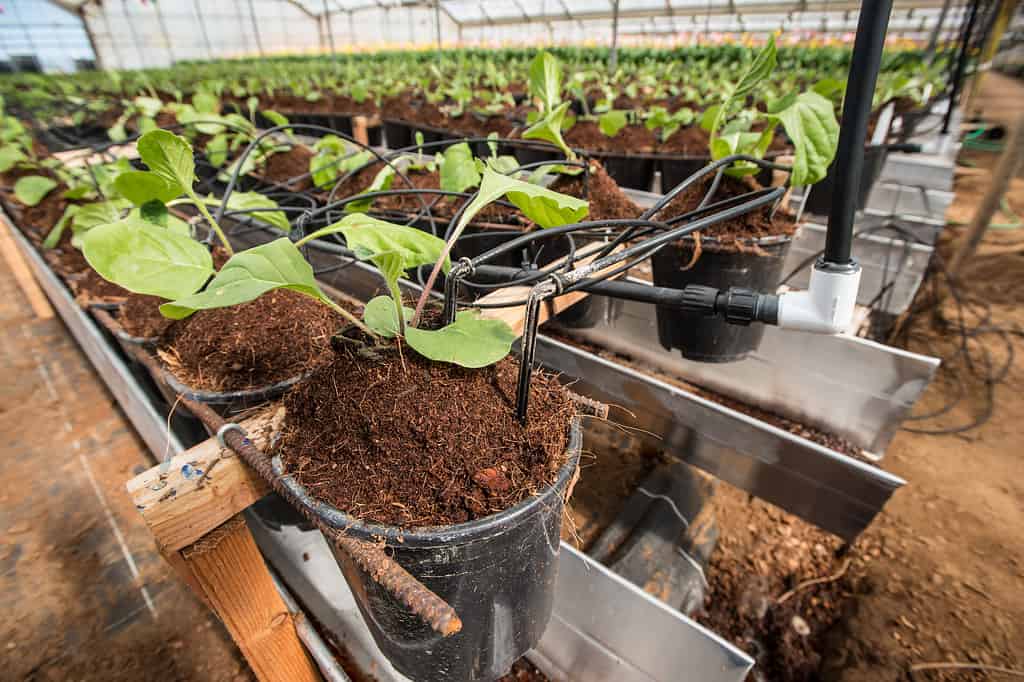
Micro irrigation, pictured, uses the same principles as drip hydroponics systems, just with soil.
©U.S. Department of Agriculture / PDM 1.0 – Original / License
Drip systems are popular with commercial hydroponics growers due to their ease of setup and control. As the name suggests, drip systems take water and nutrients from your reservoir and deliver a constant, slow drip to the plant, providing continuous moisture and food. This system works just as well for soil-potted plants and is used in gardens worldwide.
Like ebb and flow systems, drip systems require a bit of tubing to deliver water to your plants effectively. These drip systems also utilize air stones or bubblers to provide direct oxygen to the plants’ roots. Some think drip systems are a happy medium between DWC and ebb and flow systems.
If you’re a hydroponics beginner, the drip system may not be the best option for getting started. The system includes many more variables than the others, though they remain relatively constant once set. Also, drip systems may be one of the easiest to expand.
Once you decide on your system, your choice will inform other decisions. Some growth mediums — which stabilize the plant’s roots and serve as a soil alternative — suit specific systems. Net pots, coco coir, perlite, and expanded clay pellets all work well in the above three systems.
The Tomatoes
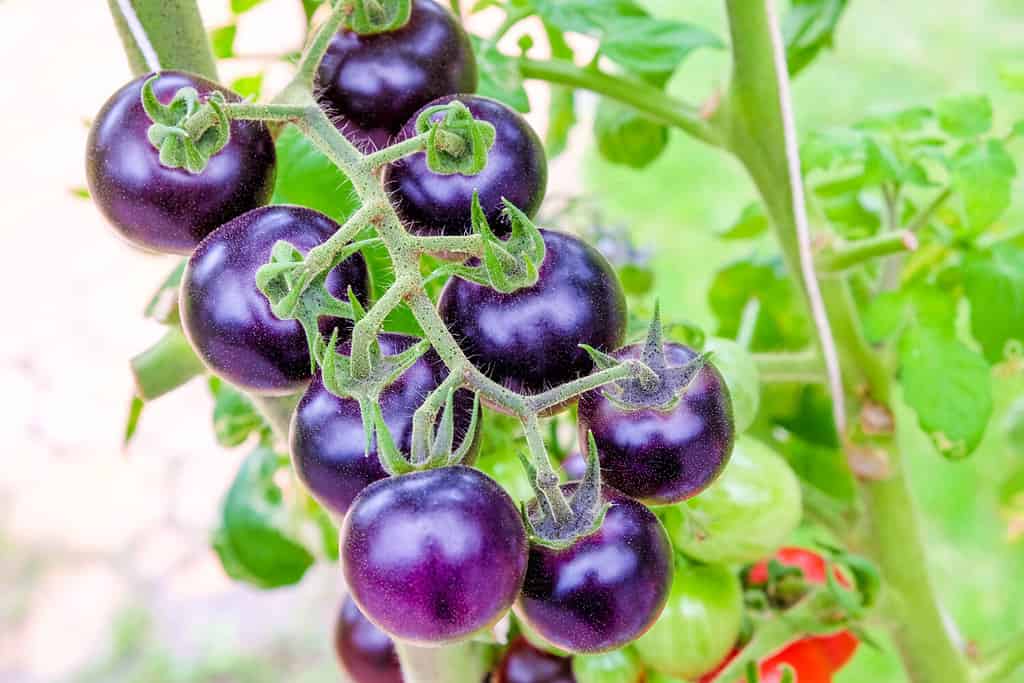
Growing beautifully colored heirloom tomatoes is one of the joys of a home hydroponics garden.
©Nattapol_Sritongcom/Shutterstock.com
Seeds and small starts are great options for your hydroponics garden. With starts, you won’t have to wait for seeds to germinate, though you will have to clean the start’s dirt roots. This three-step process just takes time. First, gently shake most of the dirt from the plant’s roots. Then, run a gentle stream of water over the roots, rubbing away any stubborn clumps. Lastly, a 10-minute soak in cool water will remove any remaining soil before you put your plants in your preferred growth medium and install it in your system.
Seeds and Planting
With seeds, germination and transplanting will take a little longer. However, you’ll have more options regarding the variety of tomatoes to grow, including unique heirloom types. Seeds are also much more cost-effective than plant starts, so seeds are the best choice if you have a budget. Tomatoes come in two broad varieties: determinate and indeterminate. There are several differences, but as a broad stroke, determinate varieties grow like bushes while indeterminate varieties grow like vines. It’s up to you to choose which variety is suitable for your space and setup, but generally, determinate varieties don’t take up as much room in a hydroponics setup.
Once you choose your seeds, you can start them directly in your new hydroponics setup. Starter plugs or cubes of rapid rooter make starting seeds easy — sprinkle a seed or three into each one, set it in your system using a net pot, and wait for germination. Remember, there’s no guarantee that every seed will sprout. If you added more than one seed to a cube, prune all but the healthiest sprout in a week or two to keep them from overcrowding. As your seeds grow, like in traditional gardening, you’ll need to increase their pot size to accommodate their growing root system. You can directly add the seedling’s growth medium to more medium in a larger pot — a far easier process than soil transplants!
The Best Environment for Tomatoes
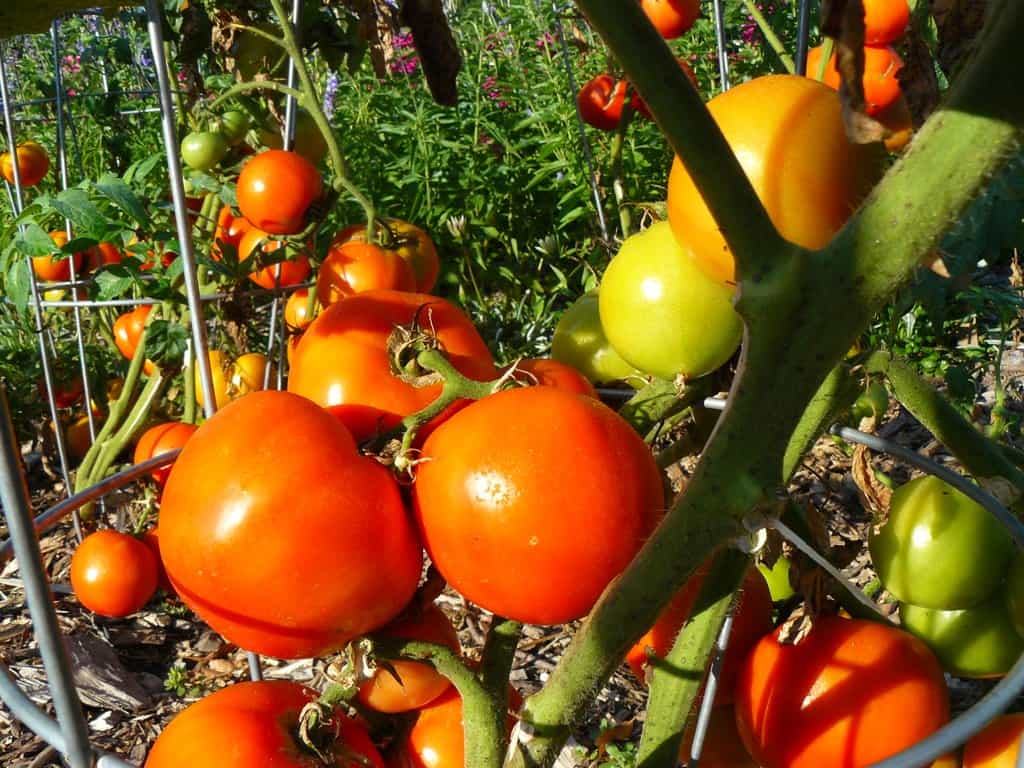
Tomatoes like warm, summery environments. You can recreate these conditions for your hydroponic tomatoes.
Though hydroponics systems can be used outdoors, a vast majority of the systems are for indoor growing. This means you don’t have to worry about freak storms or early frosts, but you’ll also need to provide all the other things tomatoes need from the outside world, like sunlight, nutrients, pollination, and heat. Let’s break it down.
Sunlight
Depending on where you place your setup, you might get a little natural sunlight on your plants. However, for their best harvest and production, tomatoes need up to 16 hours of artificial light when inside. Grow lights compensate for the lack of natural light and aren’t expensive. You can find a wide range of grow lights for any budget. However, Broad-spectrum LED or fluorescent lights work just as well and are far more affordable. Just ensure your light fits your setup — long and skinny or square lights offer great lighting for differently-sized setups.
Heat
Tomatoes love the summertime heat. It follows, therefore, that to grow indoors, you’ll need to keep your plants sufficiently warm. Your plants will love temperatures between 70 to 80 degrees Fahrenheit during the day and 63 to 65 degrees at night. However, air temperature isn’t the only thing to consider. Water that’s too hot or cold will shock your plants — aim to keep your water between 60 and 80 degrees, preferably within the 68 to 72-degree range. In addition to maintaining proper temperatures, make sure you also include some ventilation or air movement to eliminate stagnant air.
Nutrients
Without soil, you need a way to feed your tomatoes. These plants especially benefit from various nutrient types — particularly one that focuses on foliage while the plant is young and another that focuses on flowering and fruiting later. Your nutrient mixes will have a mixture of nitrogen (N), phosphorus (P), and potassium (K). The foliage mix will hover at an N-P-K ratio of 10-5-14, while the flowering ratio will lean into the phosphorus at 5-15-14.
The pH balance and electrical conductivity (EC) are other elements you must consider when considering your water and nutrient mix. The pH scale measures how acidic something is on a scale from zero to 14. Tomatoes like a mildly acidic environment, so it’s important to keep your pH between 5.5 and 6.8 for your plant’s optimal health.
Meanwhile, EC helps measure the nutrient density within a hydroponics system’s water as an alternative to parts-per-million (PPM). The more nutrients in the water, the more conductivity. The EC range tomatoes crave falls between 2.0 and 5.0 — some experts recommend a slow ramp-up to this level, as seedlings and young sprouts won’t need such a high concentration. For ease of use, you can find meters that combine pH readers and EC readers into the same machine.
Pruning and Supporting
As your tomatoes grow, you’ll want to prune and support them to maximize growth and plant health. You may not have space for a traditional tomato cage, but other trellises or stakes will work just as well. Certain varieties of tomatoes also grow more compactly and may be a better choice for indoor growing. As for pruning, most hydroponics growers recommend “topping off” your plants to encourage them to grow out rather than up. Other tomato pruning practices also apply in hydroponics, such as removing suckers and carefully clearing leaves for better airflow.
Pollinating
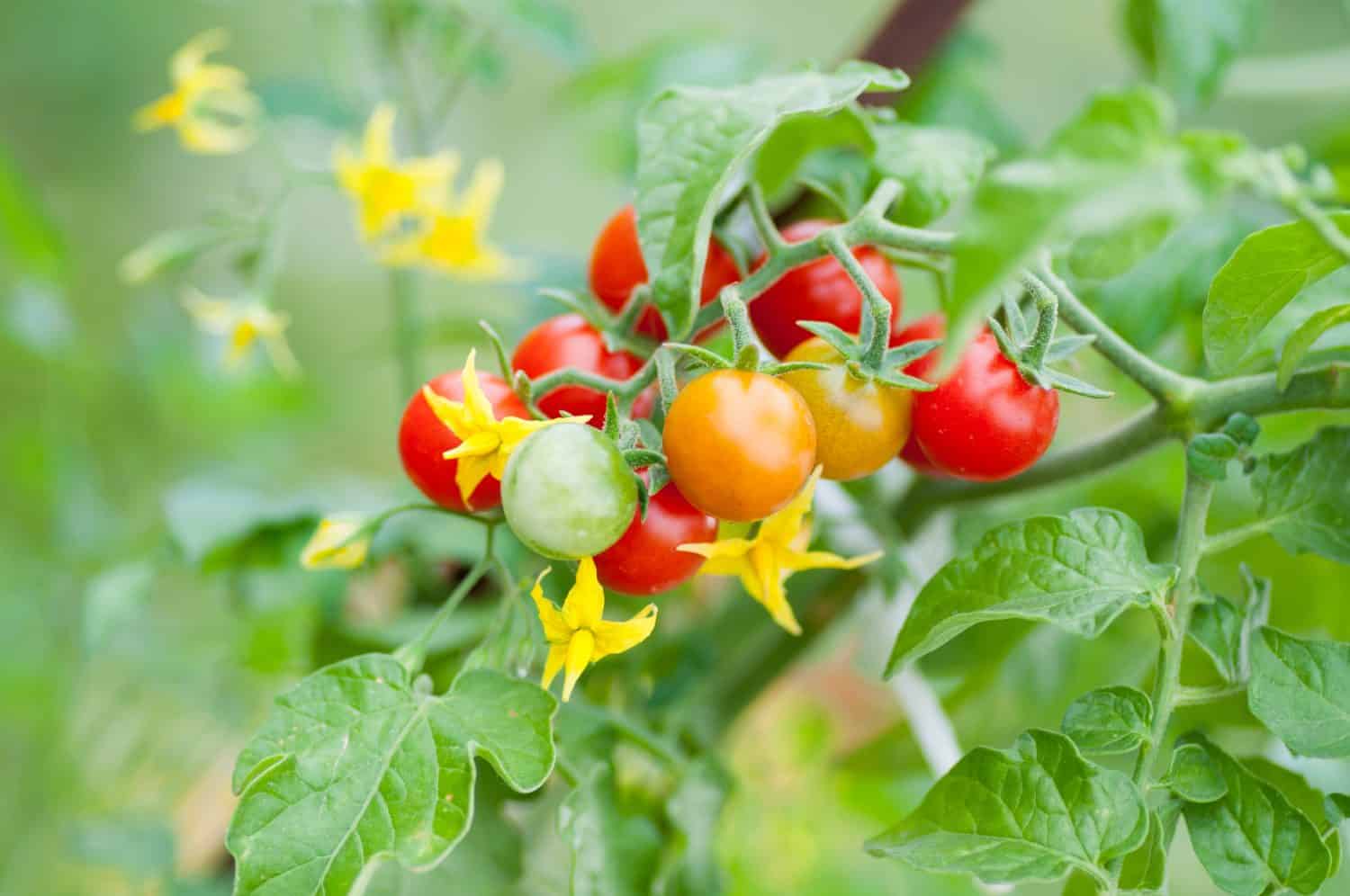
Tomato flowers contain pollen that needs to be distributed.
Image: Yuriy Korzhenevskyy, Shutterstock
©Yuriy Korzhenevskyy/Shutterstock.com
Tomatoes don’t need much to pollinate themselves. When grown outside, the bees and other bugs are happy to help. However, growing indoors means you may have to step in and help play the role of pollinator to ensure your harvest. Unlike other plants, you can gently tap each flower to shake some of its pollen loose. Some gardeners use fans to simulate wind and help distribute the pollen.
Maintenance

Your tomatoes may thrive, but they still need regular checkups and maintenance.
©New Africa/Shutterstock.com
The hard part is done — your system is flowing, and your plants are growing. However, this is no time to sit idle. Staying on top of a maintenance schedule will help keep your garden area tidy and healthy.
Daily Maintenance
For the best results, check your plants daily. Most gardeners recommend keeping a journal that records changes to your plants. This helps you identify potential problems as early as possible and gives you a guide for future years of gardening. Also, daily checks will help you train or prune your plants into manageable shapes.
Monitor your water, temperature, pH, and EC levels during your daily checks. If anything falls out of sync, your plants won’t grow as efficiently. It is better to catch any changes early than to have to scramble once your plants start to suffer.
Weekly Maintenance
Most hydroponics systems recommend flushing your reservoir and refreshing nutrient levels once a week. This helps eliminate extra, unabsorbed compounds that can clog up your system while ensuring your plants have all the necessary nutrients. This process is also a great time to check your system for leaks.
Monthly Maintenance
Monthly cleanings are a must for hydroponic systems that use pumps of some type. This is more than just a rinse — your system depends on this little pump, so ensuring it’s in clean, working order is vital. Check the pump instructions for cleaning directions and any maintenance needs. This step is essential, so try to build a routine.
Last Steps
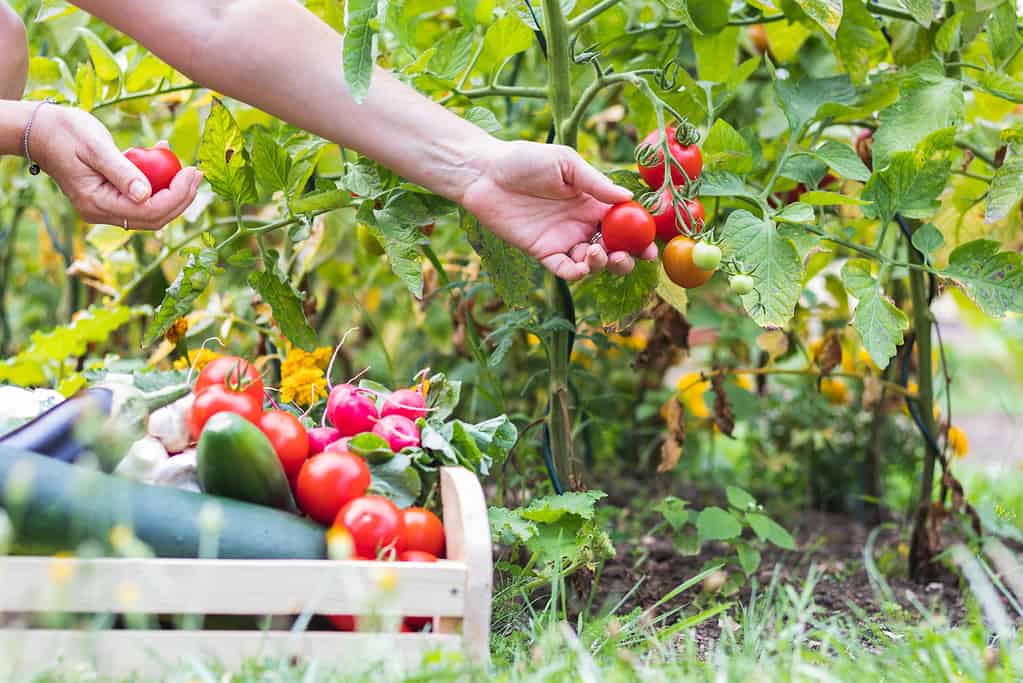
Now, you can enjoy your delicious, homegrown hydroponic tomatoes!
©iStock.com/Zbynek Pospisil
It won’t be long until you enjoy the fruits of your labor. Does anything taste better than homegrown veggies? Even better, with an indoor hydroponics system, you won’t have to fight with birds and other critters for your harvest. Tomatoes also continue to ripen off the vine, so if some fall off or get accidentally plucked, keep them on the counter for a bit. Hydroponics tomatoes make a great year-round food option that hopefully gives you the confidence to incorporate new plants into your setup.
Other plants that need nutrients and EC levels similar to tomatoes include other nightshade family members and high-nutrient herbs. Peppers, eggplants, tomatillos, and basil would all make great additions to your indoor garden without adjusting your nutrient levels too much.
The photo featured at the top of this post is © Valery Rybakow/Shutterstock.com
Thank you for reading! Have some feedback for us? Contact the AZ Animals editorial team.







